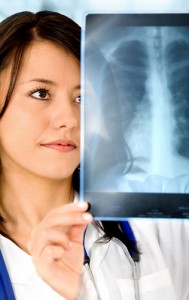 In the quest to be proactive and stay healthy, I often recommend that my patients have preventative screening imaging tests like mammograms, etc, when indicated. As well, my patients’ dentists also recommend that they have once a year x-rays to be sure they are not overlooking a problem brewing somewhere in their teeth. All these imaging tests can add up to a lot of radiation exposure. That’s what I’d like to talk to you about here – being aware of how much radiation exposure you’re getting from medical imaging tests to decrease your chance of developing cancer.
In the quest to be proactive and stay healthy, I often recommend that my patients have preventative screening imaging tests like mammograms, etc, when indicated. As well, my patients’ dentists also recommend that they have once a year x-rays to be sure they are not overlooking a problem brewing somewhere in their teeth. All these imaging tests can add up to a lot of radiation exposure. That’s what I’d like to talk to you about here – being aware of how much radiation exposure you’re getting from medical imaging tests to decrease your chance of developing cancer.
Should You Limit Medical Imaging?
The short answer to that question is, yes. In fact, a new U.S. government-funded study has shown that people under the age of 65 are chronically being exposed to high, potentially cancer-causing levels of radiation from medical imaging tests. The highest exposure to radiation from imaging tests occurs in women and older adults – especially those who undergo myocardial perfusion scans (nuclear stress tests) to diagnose heart disease.
Another earlier study in 2007 revealed that an estimated 2% of diagnosed cancers are related to CT scan exposure alone! In addition, women’s groups have questioned the rationale of yearly screening mammograms as a woman’s risk for breast cancer increases, as she gets older.
However, the longer answer gets confusing as some medical conditions (like heart disease and some cancers) require follow up nuclear imaging, required by many doctors. The contradiction between the recommended frequency of imaging and new research findings can leave a patient confused and afraid about repeated testing.
How Much Exposure Is Too Much?
As I explain to my patients, radiation exposure is measured in millisieverts, or mSv. Every year you may get about 3-mSv radiations just from environmental sources such as the sun, soil, overhead electrical sources, etc. In fact, just taking a coast-to-coast airplane trip can contribute 0.03 mSv. If you’re a frequent, once a week or more, business flyer your exposure increases considerably. Not surprisingly, the cancer rates for flight attendants and airline pilots are higher than average.
Exposures between 3-mSv and 20- mSv a year are thought to be moderate exposure. Consider, that one myocardial perfusion scan delivers about 15-mSv and already you’ve racked up 18-mSv. If you also need a mammogram or CT imaging for, say a fracture that might occur, you’re well over the moderate limit for radiation exposure for the year and are at higher risk for developing cancer. People also may get more radiation dosage from these tests, as technicians sometimes do not adjust dosage for body weight size. This can frequently happen in busy imaging clinics.
Here are some common imaging tests and their level of radiation from one event:
- Chest x-ray – 0. 1 mSv
- Dental x-rays – 0.2 mSv
- Mammogram – 0.7 mSv
- Brain PET scan – 1.0 mSv
- CT head – 2.0 mSv
- PET scan heart – 11. 8 mSv
- CT heart – 24 mSv
For added perspective, radiation exposures that occurred to residents of Chernobyl after the nuclear reactor accident in 1986, and Japanese people who survived the atomic bomb blasts of WWII, were between 50 and 150-mSv. The cancer rates in these groups were also very high.
What Can You Do To Limit Exposure?
Currently, doctors are not required to keep records of how much radiation exposure medical imaging is contributing to a patient. And, except for mammograms, there are no federal guidelines in place for radiation exposure. However, you can keep track of how much exposure you’re getting from your medical tests. Here’s what I recommend:
- Ask your doctor if the imaging test, or x-ray, is absolutely necessary to diagnose a condition. Ask if there is an alternative to the test. Often doctors like to make use of the most modern technologies, however, they may also carry more radiation risk. Ask exactly how much mSv are in one test.
- Be sure and ask the technician if they have adjusted the dose for your size.
- Keep your own “radiation medical record” listing when you had a test and how much mSv they contained. The Food and Drug Administration is working on requiring radiation doses printed on equipment, or x-rays, so doctors and patients are aware.
Although medical imaging tests can impart significant diagnosing information to a doctor, the risks and benefits of repeated imaging must be weighed carefully for each individual patient. If your doctor recommends that you have once or twice a year high-radiation imaging tests, talk to him/her about your concerns of too much exposure.
Stay well,
Mark Rosenberg, M.D.
Americans Get Most Radiation From Medical Tests, http://www.usatoday.com/news/health/2010-06-14-radiation-scans_N.htm
Too Much Radiation From Medical Imaging? http://www.webmd.com/healthy-aging/news/20090826/too-much-radiation-from-medical-imaging
photo credit: surgerynevellsroad.co.uk
